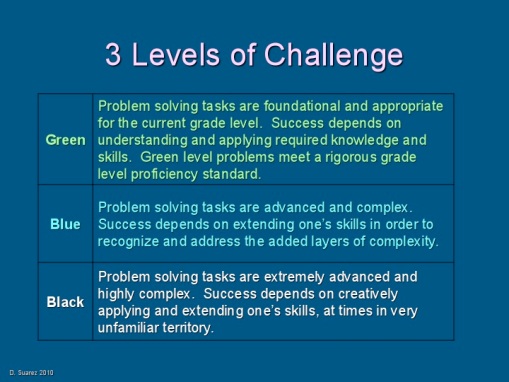1. Define Challenge Levels
Defining your tiers is an important first step before you tier assignments and assessments. Here are three possible definitions.
2. Find Tiered Problems
GREEN – STANDARD
We frequently use textbook problems (rather than worksheets) for Green level practice as this helps us ensure that green level problems reflect a rigorous grade level proficiency standard. This is a critical understanding for everyone to share. Does this mean the green level learning experience is entirely textbook driven? Absolutely not. We use NCTM standards to guide our decisions about what students need to learn and strive to deliver concept driven lessons. However, the textbook is a helpful resource for gauging appropriate difficulty levels of practice problems. We supplement the textbook often, but feel most comfortable if we’re able to hold up a grade level textbook and say, “the problems in this textbook reflect the green challenge level that students should be able to succeed with at the current grade level.” We don’t want any confusion about the fact that Green problems represent a highly respectable standard of achievement that all students can feel proud to master. That’s the main point.
BLUE – ADVANCED
Occasionally, textbook publishers indicate that certain problems are most appropriately reserved for advanced students. These problems often represent the beginning of what students should be able to do at the Blue challenge level. It goes without saying (though I reiterate this point for students repeatedly) that students who expect to succeed at the Blue level must be able to do all Green level problems. Consequently, Blue assignments and assessments carry the implicit expectation that students are capable of all green level problems. Beyond the advanced textbook problems, Blue level assignments are heavily supplemented with problems from additional resources. Textbook publishers often provide additional challenge resources related to each textbook section’s topic of study. These are good starting points for advanced problems. A few valuable resources include: the Math Forum’s problem library, Edward Zaccaro’s Challenge Math books, Art of Problem Solving books, and Mathcounts problems.
BLACK – HIGHLY ADVANCED
One of the most challenging aspect of implementing a tiered instructional program is finding or developing high level problem solving opportunities for exceptionally gifted and motivated students. I explain to students that my standard for an appropriate black level problem is that it must challenge me. I’m quick to admit that many of my students are much brighter than I am. My goal is always to assign black level problems that have a connection to the topic being studied. Most often, this connection is extremely clear. Sometimes, the connection is more of a stretch. Our goal is to provide the chance for every student to be engaged through challenge. Helpful resources include those mentioned for Blue level problems.




Dave,
This site has inspired me to try new things in my math classes. I am currently teaching at North Jakarta International School (NJIS) and needed a spark. Thanks for helping me with that.
Now to give back. I have been using an amazing resource for great challenge questions from the University of Waterloo (Canada… where I’m from) in the form of Math circles. Topics come with introduction questions as well as exercise questions divided into Junior, Intermediate and Senior topics. I hope that you will find them useful! (http://www.cemc.uwaterloo.ca/events/mathcircle_presentations.html)
If you are still in Jakarta, I would really appreciate learning more from you if possible. This is my second year teaching, and I need some more development oppertunities.
Thanks again,
Ruth
Awesome, Ruth. Thank you so much for mentioning the Waterloo resource that’s helped you. Funny that you’re just down the road – shouldn’t be hard at all to facilitate some cross school learning. Let’s make it happen.